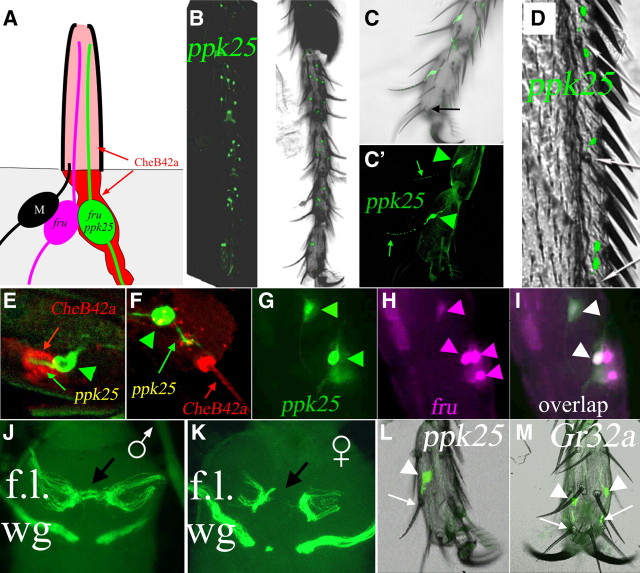Figure 3.
ppk25-Gal4 is expressed in a small subset of gustatory neurons implicated in sexual behavior. A, Schematic drawing of a gustatory hair of the leg. The dendrites of two to four gustatory neurons (only the two fru-expressing neurons are shown) extend through the hair lumen to the terminal pore where they can interact with chemicals in the environment (Shanbhag et al., 2001). One neuron expresses both ppk25 and fru (green), while another expresses fru but not ppk25 (magenta; see Results). A single mechanosensory neuron (M, black) in each hair has much shorter, stout dendrites that terminate at the base of the hair (Shanbhag et al., 2001). The CheB42a protein is expressed in non-neuronal cells (red) that surround the ppk25-expressing neuron and its dendrites and is secreted into the lumen of the taste hair (Park et al., 2006; Starostina et al., 2009) (see Results). B, Expression of membrane-tethered mCD8-GFP under control of the ppk25-Gal4 driver is present in most taste hairs of all legs (male foreleg shown). C, Higher magnification shows that expression is confined to only one gustatory neuron per taste hair. C and C′ show superimposed fluorescent and bright light images, or fluorescence only, respectively. In this experiment, ppk25-Gal4 drives expression of tau-GFP, a reporter protein that localizes to neurites (Murray et al., 1998). In each of two GFP-expressing cells visible in this field, a dendrite extends through the whole length of the hair shaft (C′, green arrow), indicating that expression occurs in gustatory neurons. Of six taste hairs in the terminal leg segment (Meunier et al., 2000, 2003), only two hairs in the proximal part of the segment house a mCD8-GFP-labeled gustatory neuron (only one of which is seen in this optical section). There is no reporter gene expression in taste hairs closer to the leg tip which contains food-sensing neurons (one such hair in focus in C is indicated by a black arrow)(Meunier et al., 2000, 2003). D, In the wing also, ppk25-Gal4 drives expression of mCD8-GFP in a single gustatory neuron in each taste hair. E, F, CheB42a, a male-specific gene immediately upstream of ppk25 (Fig. 1A) is expressed in non-neuronal support cells (Park et al., 2006; Starostina et al., 2009), in the same taste hairs as ppk25-Gal4-expressing gustatory neurons. E, CheB42a-expressing non-neuronal sheath cells labeled with anti-CheB42a antibody (red) surround a gustatory neuron that expresses mCD8-GFP under control of ppk25-Gal4 (green, cell body indicated by arrowheads; dendrite by arrows). F, Optical section through the shaft of a taste hair showing secreted CheB42a in the lumen of a taste hair penetrated by the dendrite of a ppk25-Gal4-expressing neuron. G–I, Taste neurons expressing nuclear GFP under control of ppk25-Gal4 (G, in green) also express tdTomato::nls under control of fru-LexA (Mellert et al., 2010) (H, I, tdTomato::nls in magenta, overlap of tdTomato::nls and GFP in white). J, K, The taste neurons expressing mCD8-GFP under control of ppk25-Gal4 in the front legs send sexually dimorphic projections to the first thoracic ganglia. Gustatory neurons expressing ppk25-Gal4 in the front legs (f.l.) make projections that cross the midline in males (J, arrow), but not females (K), as reported for fru-expressing gustatory neurons (Possidente and Murphey, 1989; Boll and Noll, 2002; Mellert et al., 2010). In contrast, the projections from ppk25-Gal4-expressing neurons on the wings (wg) and from the second and third pairs of legs (data not shown) do not cross the midline in flies of either sex. L, M, ppk25 and Gr32a, gustatory receptors that inhibit courtship behavior (Miyamoto and Amrein, 2008; Koganezawa et al., 2010; Wang et al., 2011), are expressed in nonoverlapping patterns. Observations of the fifth tarsal segment show that dendrites of ppk25-Gal4 expressing gustatory neurons (only one of two ppk25-Gal4-expressing neurons is visible in this side view) penetrate the shaft of taste hairs in the center of the tarsal segment (L, cell body indicated by arrowhead, arrow points to base of the corresponding taste hair), whereas dendrites of gustatory neurons that express Gr32a-Gal4 enter taste hairs that are closer to the leg tip (M, cell bodies indicated by arrowhead, arrows points to bases of the corresponding taste hairs).

